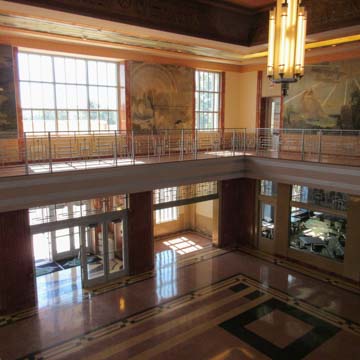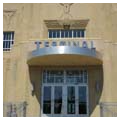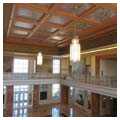Planned to accommodate seaplanes as well as land-based craft, Lakefront Airport was built on land dredged from Lake Pontchartrain to create a site that projects into the lake. The initial plans for the airport were drawn up by William E. Arthur of Los Angeles, who was replaced in 1932 by Weiss, Dreyfous and Seiferth. Following Arthur’s earlier concept, the airfield’s buildings were laid out on the triangular-shaped site in a winged arrangement symbolizing flight; the central terminal building was given a similar outline. Both the exterior and interior are lavishly ornamented with relief sculptures that allude to flight. Above the main entrance is a figure of man as a flying machine, flanked by window panels with similar representations; on the side walls are sculptures representing the four winds. Among the sculptors who created these works were Enrique Alferez, William Proctor, and John M. Lachin. This beautiful facade–Weiss, Dreyfous and Seiferth had reached their peak in the integration of sculpture and architecture by the early 1930s–was covered in 1964 by a windowless wall in order to save the expense of needed exterior repairs and to enable the airport to function as an atomic fallout shelter. The wall was removed and the building renovated to its former Art Deco glory in 2013. Inside, the double-height lobby’s terrazzo floor; rose-, cream-, and beige-colored marble paneling; streamlined aluminum stair railings and light fixtures; and plaster friezes of mechanical tools and of cloud and sun motifs all convey the magical and modern aura of early flight. At balcony level eight murals by Xavier Gonzalez, now restored under the direction of Elise Grenier, depict exotic destinations from the air (a compass on the lobby floor points to these destinations, noting the mileage from New Orleans).
Funded originally at a cost of $4 million (the recent renovation far exceeded this amount) and supervised by the Orleans Levee Board, the airport was named, despite considerable public protest, for the board’s president Abe Shushan, who had his initials inscribed throughout the terminal, reputedly in more than a thousand places, from doorknobs to roof. Shushan, a friend of Governor Huey P. Long, was indicted for income-tax evasion in 1935. He was subsequently acquitted, but in 1939 the Orleans Levee Board nonetheless renamed the airport and ordered the removal of every trace of Shushan’s name. Shushan was jailed for mail fraud the following year. The restored building is now a venue for events and a destination for private and charter air traffic.
On either side of the terminal are two of the original aircraft hangars, each with metal gable ends inscribed with the image of an airplane. Adjacent to the airport’s entrance is Enrique Alferez’s Fountain of the Four Winds (1938), which is composed of four nine-foot-high nude figures of cast stone representing the winds, grouped around a hemisphere and surrounded by a pool. Three of the figures are female; the male figure, representing the north wind, was heavily criticized in its time by citizens who regarded its nudity as harmful to public morals. Although the building has been restored, the fountain has not, though there is speculation it might be moved to a new site and restored.






















